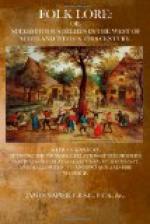In 1860, I was residing near the head of Loch Tay during the season of the Hallowe’en feast. For several days before Hallowe’en, boys and youths collected wood and conveyed it to the most prominent places on the hill sides in their neighbourhood. Some of the heaps were as large as a corn-stack or hay-rick. After dark on Hallowe’en, these heaps were kindled, and for several hours both sides of Loch Tay were illuminated as far as the eye could see. I was told by old men that at the beginning of this century men as well as boys took part in getting up the bonfires, and that, when the fire was ablaze, all joined hands and danced round the fire, and made a great noise; but that, as these gatherings generally ended in drunkenness and rough and dangerous fun, the ministers set their faces against the observance, and were seconded in their efforts by the more intelligent and well-behaved in the community; and so the practice was discontinued by adults and relegated to school boys. In the statistical account of the parish of Callander, the same practice is referred to. It is stated that “When the bonfire was consumed, the ashes of the fire were carefully collected in the form of a circle, and a stone put in near the circumference for every person in the several families concerned in getting up the fire; and whatever stone is moved out its place or injured before next morning, the person represented by the stone is devoted or fey, and is supposed not to live twelve months from that day.” In all probability this devoted person was in olden times offered as a sacrifice to the fire god on the great day of sacrifice, which was the festival day. The belief that the spirits of the dead were free to roam about on that night is still held by many in this country. Indeed, where the forms of the feast have all but disappeared, the superstitious auguries connected with it survive. Burns particularises very fully the formulae of Hallowe’en, as practised in Ayrshire in his day, and as this poem is well known, it would be superfluous to follow it in detail here; but I cannot refrain from drawing attention to the suggestions which one of the practices which he mentions affords in favour of the supposition that it is a relic of an ancient form of appeal to the fire god—I refer to the practice of burning nuts. It seems likely that in ancient times the priests, who claimed prophetic power through the reading of auguries, used this method of deciding the future at this particular season of the year, and chiefly during the holding of the feast.
Although I have confined my remarks to the four feasts, Yule, Beltane, Midsummer, and Hallowe’en, because they are the oldest and most properly national, there were a number of other heathen feasts, emanating principally from Roman practice, which the Church converted into Christian feasts, notably what is now called Candlemass. On the second day of February, the Romans perambulated their city with torches and candles burning in honour




